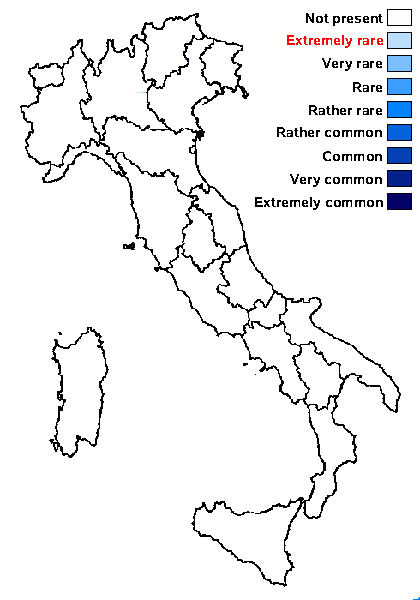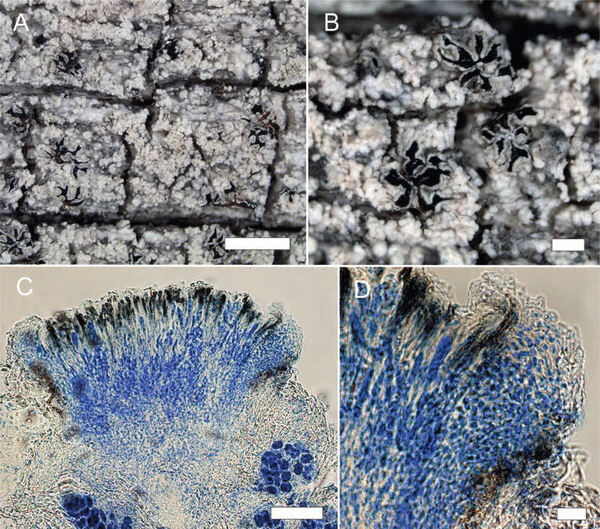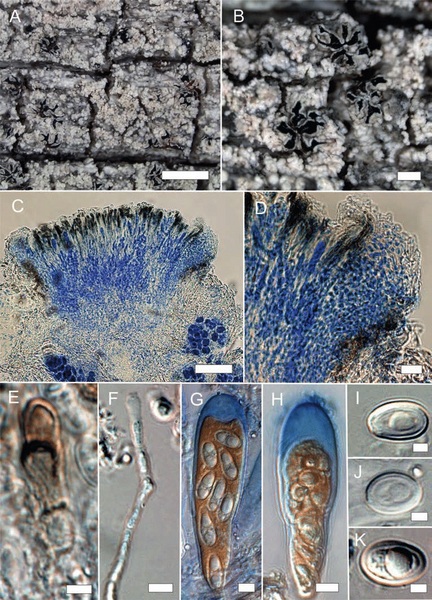Xylographa lagoi T. Sprib. & Pérez-Ort.
in Spribille & al., Symb. Bot. Upsal., 37, 1: 45, 2014
Synonyms:
Distribution:
Description: Thallus crustose, areolate, mostly episubstratic but sometimes partly endosubstratic in areas lacking goniocysts; areoles convex, usually developing convex, white, rounded, finally confluent soralia producing rather coarse, more or less corticate, up to 90 µm wide goniocysts (soredia). Apothecia frequent, elongated, up to 0.3 mm wide, forming up to 1.2 mm wide, star-like clusters, the disc flat to slightly concave, jet black, the margin white, flexuose. Exciple up to 50 µm wide, brownish in outer part, almost colourless within, paraplectenchymatous, of thin-walled hyphae; epithecium grey-brown to greenish brown, K+ dark brown; hymenium colourless, up to 100 µm high; paraphyses septate, more or less straight, simple or sparingly branched in upper part, often anastomosing, 2-3 µm thick at mid-level, the apical cells elongated, often up to 7 µm wide. Asci 8-spored, clavate-cylindrical, unitunicate, the gelatinous sheaths covering the walls amyloid, the tholus lacking internal amyloid structures, similar to that in Trapelia. Ascospores 1-celled, hyaline, ellipsoid to ovoid, irregularly biseriate, (7.5-)9.5-11.5 x (5.5-) 6-7.5 µm, the wall up to 1.5 µm thick. Photobiont chlorococcoid. Spot tests: thallus K+ yellow, C-, KC-, P+ yellow. Chemistry: thamnolic acid.Note: a very rare, recently-described species, hitherto known only from the type locality in Spain; to be looked for in Italy.
Growth form: Crustose
Substrata: bark
Photobiont: green algae other than Trentepohlia
Reproductive strategy: mainly sexual

Predictive model

Toby Spribille Spribille, T./ Resl, P./ Ahti, T./ Pérez-Ortega, S./ Tønsberg, T./ Mayrhofer, H./ Lumbsch, H.T. 2014: Molecular systematics of the wood-inhabiting, lichen-forming genus Xylographa (Baeomycetales, Ostropomycetidae) with eight new species. - Acta Universitatis Upsaliensis, Symbolae Botanicae Upsalienses 37(1): 1-87

Toby Spribille
Source: Spribille, T./ Resl, P./ Ahti, T./ Pérez-Ortega, S./ Tønsberg, T./ Mayrhofer, H./ Lumbsch, H.T. 2014: Molecular systematics of the wood-inhabiting, lichen-forming genus Xylographa (Baeomycetales, Ostropomycetidae) with eight new species. - Acta Universitatis Upsaliensis, Symbolae Botanicae Upsalienses 37(1): 1-87
Growth form: Crustose
Substrata: bark
Photobiont: green algae other than Trentepohlia
Reproductive strategy: mainly sexual

Predictive model

Toby Spribille Spribille, T./ Resl, P./ Ahti, T./ Pérez-Ortega, S./ Tønsberg, T./ Mayrhofer, H./ Lumbsch, H.T. 2014: Molecular systematics of the wood-inhabiting, lichen-forming genus Xylographa (Baeomycetales, Ostropomycetidae) with eight new species. - Acta Universitatis Upsaliensis, Symbolae Botanicae Upsalienses 37(1): 1-87

 Index Fungorum
Index Fungorum
 GBIF
GBIF

